Armed Forces of Belarus
The Armed Forces of the Republic of Belarus (Belarusian: Узброеныя сілы Рэспублікі Беларусь [УС РБ], Uzbrojenyja siły Respubliki Biełaruś, Russian: Boopyжённыe cилы Pecпyблики Бeлapycь, Vooruzhennye sily Respubliki Belarus) consist of the Ground Forces and the Air and Air Defence Forces, all under the command of the Republic of Belarus Ministry of Defence. Being a landlocked country, Belarus has no navy.
| Armed Forces of the Republic of Belarus | |
|---|---|
| Узброеныя сілы Рэспублікі Беларусь (Belarusian) Вооружённые силы Республики Беларусь (Russian) | |
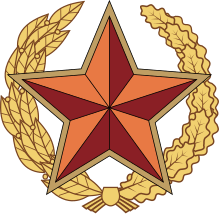 Emblem of the Belarusian defense ministry | |
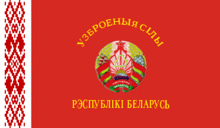 Flag | |
| Founded | 1992 |
| Service branches | Ground Forces[1] Air Force Special Forces of Belarus Transport Troops Territorial Troops |
| Headquarters | Defense Ministry, Minsk, Belarus |
| Leadership | |
| Commander-in-chief | |
| Minister of Defense | |
| Chief of the General Staff | |
| Manpower | |
| Active personnel | 62,000 [2][3] |
| Reserve personnel | 344,750 |
| Deployed personnel | 4,560 (Around the borders)[4] |
| Expenditures | |
| Budget | $780 million (2019)[5] |
| Percent of GDP | 1.2% (2018) |
| Industry | |
| Domestic suppliers | Belarusian Plant of Precision Electromechanic Kalashnikov |
| Foreign suppliers | |
| Related articles | |
| Ranks | Military ranks of Belarus |
In 2017 the IISS estimated that personnel in the armed forces numbered 48,000. Most soldiers are conscripts serving for a period of 18 months, although there is an alternative service option.[6]
Belarus conducted military reforms in the 2000s which have reshaped its armed forces as a relatively effective force for a small state in somewhat difficult economic conditions.[7]
History
The previous Belarusian People's Republic of March 1918 to 1919 did not have time to create armed forces in its brief existence, although attempts to create a military have been documented.[8]
Until 1991 the Soviet Belorussian Military District comprised the 5th Guards Tank Army (HQ Bobruisk), the 7th Tank Army (HQ Borisov), the 28th Army (HQ Grodno), the 120th Guards Motor Rifle Division, the 72nd Guards District Training Center and logistical units and formations. In addition to these troops Belarus was host to centrally controlled formations, namely the 103rd Guards Airborne Division, the 38th Guards Airborne Brigade, the 11th Air Defence Corps of the 2nd Air Defence Army, the 26th Air Army and also units and formations of the Strategic Rocket Forces, Long Range Aviation, the Navy and special forces.
In late 1991 the 5th Guards Tank Army comprised the 30th Guards Motor Rifle Division, newly arrived from Czechoslovakia, and the 193rd Tank Division, plus two armament and equipment storage bases (the former 8th Guards and 29th Tank Divisions), and army troops. The 7th Tank Army comprised the 3rd Guards Tank Division, 34th, and 37th Guards Tank Divisions, plus army troops. The 28th Army comprised four divisions, one of which was a low-status mobilisation division. Also arriving from the Southern Group of Forces in Hungary was the 19th Guards Tank Division.
On September 20, 1991 the Supreme Soviet of Belarus passed resolution "On the formation of the Armed Forces of the Republic of Belarus" and on January 11, 1992 resolution "On the Armed Forces deployed in the territory of the Republic of Belarus." On March 18, 1992 the parliament passed resolution "On the Armed Forces of the Republic of Belarus" that bound the government "to start the formation of the Armed Forces of the Republic of Belarus as of March 20, 1992" and "to submit to the Supreme Soviet for approval the suggested structure of the Armed Forces, their size and order of their material and technical supplies".
On May 6, 1992 the Belorussian Military District was abolished. The Belarusian Ministry of Defence and the Main Staff were formed from its resources.[9] The former first deputy commander and military district Chief of Staff, Lieutenant-General P P Kozlovskiy, was appointed Minister of Defence on 22 April 1992, taking over from acting Minister of Defence Colonel-General Petr Chaus.
On November 3, 1992, Belarus passed the law "On the Armed Forces of the Republic of Belarus" defining the status, structure and guiding principles of the Armed Forces.[10] After the introduction of presidency the law was amended twice: on September 4, 1996 and on November 9, 1999 but on the whole the law retains its initial contents.
On January 1, 1993 all service personnel on Belarusian soil were required to either take an oath of loyalty to Belarus, or leave. This oath however did not alleviate concerns regarding loyalty to Russia in time of crisis, especially since nearly 50% of all military personnel were ethnically Russian at the end of 1992.
In June 1995, President Lushenko issued a decree on the Mobile Forces. By June 1996, they comprised a headquarters in Vitebsk, two brigades drawn from the 103rd Guards Airborne Division, the 38th Independent Mobile Brigade (Brest, Belarus), an air transport regiment, and communications, logistics, and engineer units.[11]
Membership in the Commonwealth of Independent States, as well as the 1996 treaty on the Union of Russia and Belarus and the Treaty of the Formation of a Union State in 1999, confirmed a close partnership with Russia. Much of the air defence system is integrated into the Russian air defence network, and in 2006 the two nations signed an agreement on the creation of a unified air defence system.[12]
Structure
Belarus government websites say that the Ministry of Defence of the Republic of Belarus is supported by Central Command Support Elements and the General Staff of the Armed Forces.[13] Combat Support Elements of the Armed Forces included Reconnaissance, Electronic Warfare, Signals, Engineer, NBC Defence, Navigation and Topography, and Maintenance organisations. Logistic Elements of the Armed Forces provided Material Support, Logistic Support, Medical Support, Veterinarian Support, and Military Construction.
In 1995 the Military Academy of Belarus was set up on the basis of two military educational institutions – the Minsk Air Defence and Rocket School of the Soviet Air Defence Forces and the Minsk Higher Military Command School. Its 10 departments train officers of 38 specialties for practically all arms of service. Also in 1995 it was given the status of a government institution of secondary special military education for young men.
Branches
Belarus Ground Forces
Source http://www.ryadovoy.ru/forum/index.php/topic,406.0.html
A Library of Congress study of national ground forces said that in 1994 Belarus had ground forces of 52,500.[14] They were organized into three corps headquarters, two motor divisions, one airborne division, the 51st Guards Artillery Division at Osipovichi,[15] three mechanized divisions, one airborne brigade, three surface-to-surface missile brigades,[16] two antitank brigades, one special duties brigade, and seven anti-aircraft missile brigades. Equipment included 3,108 main battle tanks (seventy-nine T-54, 639 T-55, 291 T-62, 299 T-64, eight T-80, and 1,800 T-72), 419 medium-range launchers, sixty surface to-surface missiles, and 350 surface-to-air missiles.
In 1993 the 7th Tank Army was reorganised as the 7th Army Corps. In 1994 the 7th Army Corps was redesignated as the 65th Army Corps, still located at Borisov.
By January 1, 1995, the composition of the Belarusian ground forces had changed.[14] The Library of Congress study estimated at the time that Ministry of Defence forces included the 103rd Guards Airborne Division and the 38th Separate Assault-Landing Brigade; the 28th Army Corps (Grodno Region and Brest Region), composed of headquarters at Grodno, the 6th Separate Mechanised Infantry Brigade, the 11th Guards Mechanised Infantry Brigade, the 50th Separate Mechanised Infantry Brigade, the Armament and Equipment base, and corps units (missile troops, antiaircraft, chemical and engineer troops, signals, and rear services); the 65th Army Corps (Minsk and Vitebsk Regions), composed of headquarters at Borisov, three armament and equipment bases, and corps units; and the 5th Guards Army Corps (Minsk and Mahilyow regions) made up of headquarters at Babruysk, the 30th Separate Motor Rifle Brigade, two Armament and Equipment bases, and corps units.
Actually, the 103rd Guards Airborne Division had been reorganized as Headquarters, Mobile Forces, in 1993. On 1 August 1996 the 51st Guards Artillery Division was reorganised as the 51st Guards Central Group of Artillery, still located at Osipovichi.[17]
On 21 December 2001, a major reorganisation of the Ground Forces produced two operational-territorial commands, formed from two former corps headquarters.[18] All Belarus ground forces were now grouped within these two commands, the Western Operational Command at Grodno, former from the previous 28th Army Corps, the former Soviet 28th Army, and the North Western Operational Command, the former 65th Army Corps, at Barysaw (Borisov).
Since about 2001, territorial defence forces, which as of 2002 number around 150,000, have been forming, organised into battalions, companies, and platoons spread across Belarus.[18]
In 2007, the Land Forces consisted of 29,600 soldiers (6th Guards Mechanised Brigade (Grodno), 11th Guards Mechanized Brigade at Slonim, the 120th Guards Mechanised Brigade (Minsk), 38th and 103rd Mobile Brigades (organized similarly to Soviet airborne regiments, not all of them are equipped with BMD-1),[19] 5th Spetsnaz Brigade (Maryina Horka),[20] five artillery brigades and four regiments, two MRL regiments, 15th, 29th, 115th, 120th and 302nd SAM Brigades, two SSM brigades, two brigades and one regiment of engineers, 8th independent NBC Brigade, two signals brigades, 40th independent NBC battalion. Army equipment includes 1800 main battle tanks (MBT) and 2600 AFV/APC. The weapons and equipment storage bases include the 50th (Brest), 19th,[21] 34th & 37th (former tank divisions), 3rd, and 28th (Baranovichi). Weapons storage bases that have been disbanded include the 29th, 30th, 193rd, and the storage base that used to be the 8th Guards Tank Division at Marina Gorka.
In 2012 it was reported that there were six mechanised brigades in the Ground Forces: three full-strength, the 6th (Grodno), 11th (Slonim), and 120th Guards Mechanised Brigade at Minsk. The others were at reduced strength, where there was one battalion, the 19th (Zaslonova), 37th, and 50th (Baranovichi).[22] By 2017, the number of mechanised brigades had been further reduced to four, with two at full strength and two at reduced strength.[6]
Air Force and Air Defence Forces
In 2007 the Air Force and Air Defence Force of Belarus (AF & ADF) consisted of 18,170 personnel (two fighter/interceptor bases, four FGA/reconnaissance squadrons, one transport air base, training aircraft, and attack and support helicopters, SAM units). Air Force equipment included in 2004 260 fighter-ground attack/training aircraft and 80 attack helicopters. According to Belarus government websites, the Air Forces now have two commands, the Western Operational-Tactical Command and the North-Western Operational-Tactical Command.
The 61st and 927th Air Bases have now merged into the 61st (fighter) Air Base at Baranovichi, flying MiG-29s, and the 206th Air Base (Ross) has merged into the 116th Guards Assault Air Base at Lida, flying Su-25s.
Independent forces
Special Forces
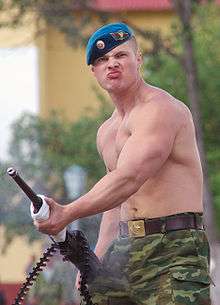
The Special Forces of Belarus is the airmobile and strategic deterrence force. It has been a participant in conflicts such as the United Nations Interim Force in Lebanon[23] and the Libyan Civil War (2011).[24]
Transport Troops
The Belarusian Transport Troops is responsible for the movement of personnel and material by truck, rail, and air. It is also designed to carry the tasks of the transport support of the military formations from other service branches. General leadership is exercised by the Minister of Defense, while direct control is carried out by the Head of the Transport Support Department, a position that reports directly to the President.
Territorial Forces
The Territorial Forces (Belarusian: Тэрытарыяльных Войскаў, Russian: Территориальных Войск) are a homeland defence organization in the armed forces. It is managed by the Department of the Territorial Forces, being a support department of the Ministry of Defence of Belarus and is operated by the General Staff. It is currently located on Kommunisticheskaya Street in Minsk. The current head of the department of territorial forces is Colonel Andrei Paseko. The Territorial Defence system was established in the early 2000s. Over 120,000 troops constitute the size of the Territorial Forces, which is twice as much as it serves in the regular duty military.[25] During an address by President Alexander Lukashenko on 18 February 2016, he announced the allocation of arms and to the territorial forces and the minimum and maximum amount of district troops ranging from one company and a battalion. Personnel of these units are recruited from residents of their respective administrative-territorial regions.[26][27][28][29][30]
Specialized forces
Special troops are designed to support the combat activities of the Ground Forces and solve their inherent tasks. They include formations and military units of intelligence, communications, engineering, radiation, chemical and biological defense, electronic warfare, navigation and topographic.[31]
- Electronic Warfare Troops
- Signal Corps
- Engineer troops
- NBC Protection Troops
- Topographic Navigation Service
Security forces
Internal Troops
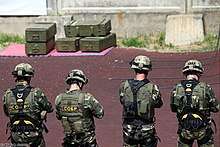
The Internal Troops of Belarus were formed from the former Soviet Internal Troops after the collapse of the Soviet Union. They consist of three independent brigades and seven independent battalions (consecutively numbered).
Manpower
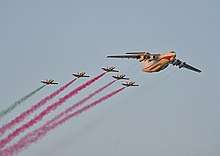
The Government Directive of 20 March 1992 ‘On the Establishment of the Armed Forces of the Republic of Belarus’ founded the Belarusian army. The Soviet troops of the BMD were smoothly converted into Belarusian military units. Yet one of the first tasks of the Belarusian government was a reduction in its numbers. 240,000 soldiers and officers were serving in the Belarusian Military District. By early 2013 the numbers of military personnel had been scaled down nearly fourfold since 1991. In February 2014, Belorusskaya Voyennaya Gazeta, the official publication of the Ministry of Defense revealed that the Belarusian Armed Forces contains about 59,500 personnel, including 46,000 soldiers and 13,000 civilians.[34]
Military commandants
The military commandants of the Armed Forces of Belarus are regional administrations tasked with overseeing Belarusian regiments in the commandant's territory. Units are assigned to a specific commandant based on their location. There are 6 military commandants in the Belarusian Armed Forces.[35]
| Commandant Name | Commander | Region |
|---|---|---|
| Baranavichy Military Commandant | Lieutenant Colonel Vladimir Pivovar | Brest Region |
| Babruysk Military Commandant | Lieutenant Colonel Vladimir Gritsuk | Mogilev Region |
| Barysaw Military Commandant | Lieutenant Colonel Ivan Kislyi | Minsk Region |
| Brest Military Commandant | Lieutenant Colonel Yuri Ivanyuk | Brest Region |
| Grodno Military Commandant | Lieutenant Colonel Alexander Lupyrev | Grodno Region |
| Minsk Military Commandant | Colonel Nikolai Kurash | Minsk Region |
Units under the command of commandants include Military police, honour guards and military bands.[36]
Equipment
The military forces of Belarus are almost exclusively armed with Soviet-era equipment inherited from the Soviet Union. Although large in numbers, some Western experts consider some of it outdated.
“The Belarusian armed forces receive around 100 brand-new and upgraded systems a year,” said in late July 2018, Belarusian Deputy Minister of Defence for Armament and Chief of Armament Major General Sergei Simonenko.[37] The MBTs are of Russian type T-72, T-62, and T-55, the APCs and IFVs are of Russian type MT-LB, BMP-2, BMP-1, and the BMD-1, and Russian type trucks are the GAZ-66 and the KAMAZ-6560. While the IISS Military Balance 2016 listed 69 T-80s in service,[38] by 2018 the listing had been removed, and the only MBTs listed were 527 T-72 as well as 5 T-72B3.
The Air Force is equipped with MiG-29 fighters, Su-25 attack aircraft, as well as Mi-8, Mi-24, and some old, Polish built Mi-2 helicopters. In December 2005, Belarus bought 10 L-39C jet trainer aircraft from the Ukraine, and in 2017 a contract have been signed to buy 12 Su-30SM fighters.[39] In 2006, four batteries (divizions in Russian terminology; about 6 systems each) of S-300 anti-aircraft systems were acquired from Russia to reinforce the Joint CIS Air Defense System. The Military Balance 2018 listed a brigade with the S-300P and a brigade with the S-300V (SA-12A Gladiator/SA-12B Giant).[40]
Small arms
| Model | Image | Caliber | Origin | Type | Notes |
|---|---|---|---|---|---|
| Pistols | |||||
| Makarov PM | 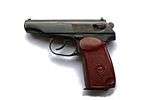 |
9×18mm Makarov | Semi-automatic pistol | ||
| Stechkin automatic pistol | 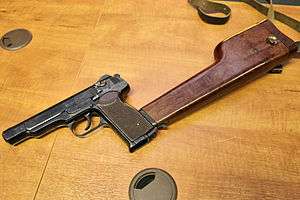 |
9×18mm Makarov | Selective fire Machine pistol | ||
| Submachine gun | |||||
| HK MP5 | 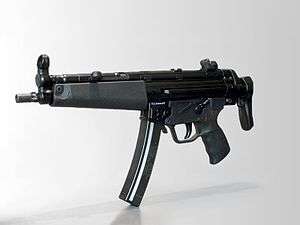 |
9×19mm Parabellum | Submachine gun | MP5A3 and MP5K variants used by OMON, "Almaz" counter-terrorist unit, MP5A3 in used by KGB Alpha Group. | |
| Assault rifles | |||||
| AK-47 |  |
7.62×39mm | Assault rifle | ||
| AKM | 7.62×39mm | Assault rifle | |||
| AK-74 |  |
5.45×39mm | Assault rifle | Standard service rifle. | |
| AK-74M | 5.45×39mm | Assault rifle | |||
| 9A-91[41] | 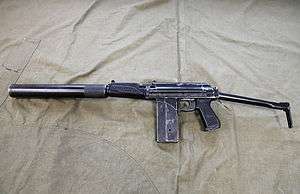 |
9×39mm | Carbine | ||
| Sniper rifles & designated marksman rifles | |||||
| VSS Vintorez[42] | 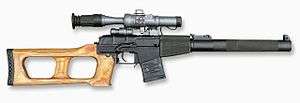 |
9×39mm | Special Sniper rifle, assault rifle | Used by various special forces. | |
| Dragunov SVD | 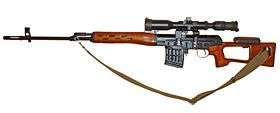 |
7.62×54mmR | Semi-automatic sniper rifle, designated marksman rifle | ||
| OSV-96[43] | 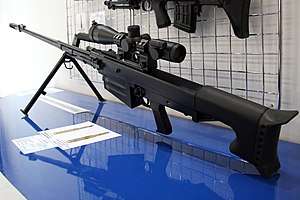 |
12.7×108mm | Anti-materiel sniper rifle | Used by the special forces. | |
| Machine guns | |||||
| PK machine gun |  |
7.62×54mmR | General-purpose machine gun | ||
| RPK | 7.62×39mm | Squad automatic weapon | |||
| RPK-74 | 5.45×39mm | Squad automatic weapon | |||
| NSV | 12.7×108mm | Heavy machine gun | |||
| Grenade launchers | |||||
| GP-25/30/34 | 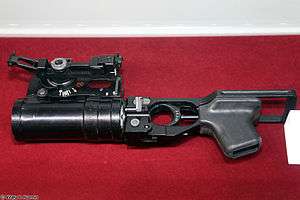 |
40mm VOG-25 | Underslung grenade launcher | ||
| AGS-17 | 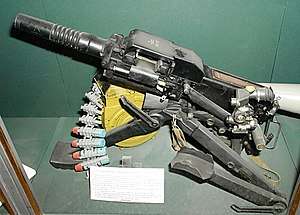 |
30×29mm | Automatic grenade launcher | ||
| AGS-30 | 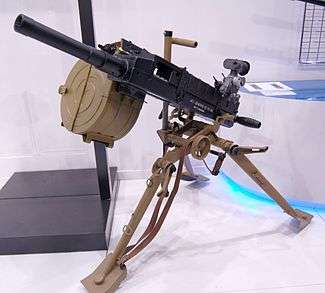 |
30×29mm | Automatic grenade launcher | ||
| Rocket propelled grenade launchers | |||||
| RPO-A Shmel[44] |  |
93mm | Rocket-propelled grenade | The PDM-A Priz is replacing the RPO-A Shmel flamethrower | |
| RPG-7 | 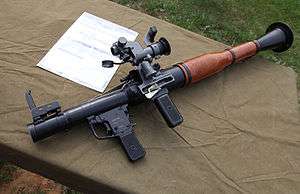 |
40mm (launcher only, warhead diameter varies) | Rocket-propelled grenade | ||
| RPG-18 | 64.mm | Rocket-propelled grenade | Single-shot disposable launcher. | ||
| RPG-22 | 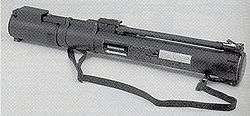 |
72.5mm | Rocket-propelled grenade | Single-shot disposable launcher. | |
| RPG-26 | 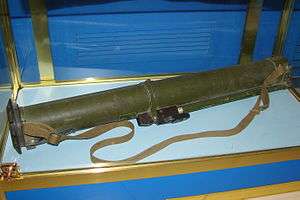 |
72.5mm | Rocket-propelled grenade | ||
| RPG-29 | 105mm | Rocket-propelled grenade | Re-loadable launcher. Can use PG-29V tandem-charge munitions in an anti-tank role, or TBG-29 thermobaric munitions in anti-infantry use. | ||
| Anti-tank guided missiles | |||||
| 9K111 Fagot |  |
120mm | Anti-tank guided missile | ||
| 9M113 Konkurs |  |
135 mm | Anti-tank guided missile | ||
| Shershen | 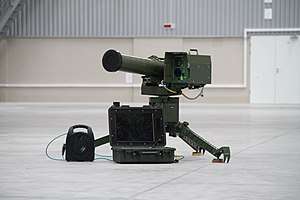 |
130mm & 152mm | Anti-tank guided missile | ||
| Man-portable air-defense systems | |||||
| 9K34 Strela-3 | 75mm | Man-portable air-defense system | |||
| 9K38 Igla | 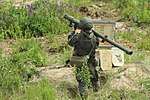 |
72mm | Man-portable air-defense system | ||
Tanks
| Model | Image | Origin | Type | Number | Notes |
|---|---|---|---|---|---|
| T-72 | .jpg) |
Main Battle Tank | 532 (inc T-72B3)[45] | Mainly T-72B version. Four mechanized brigades.[38] At least 24 upgraded to the B3M level.[46][47][48][49][50] |
Infantry fighting vehicles
| Model | Image | Origin | Type | Number | Notes |
|---|---|---|---|---|---|
| BMD-1 | 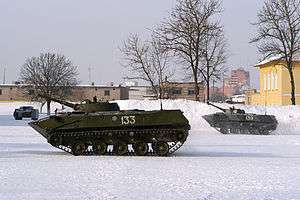 |
Airborne infantry fighting vehicle | 124 in 1995, 154 in 2000, 2003 and 2005.[51][52] | ||
| BMP-1 | 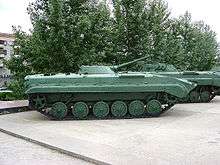 |
Infantry fighting vehicle | 132[53] | BRM-1 version | |
| BMP-2 | Infantry fighting vehicle | 932[53] | Two mechanized brigades.[53] | ||
Armored personnel carriers
| Model | Image | Origin | Type | Number | Notes |
|---|---|---|---|---|---|
| BTR-70 | 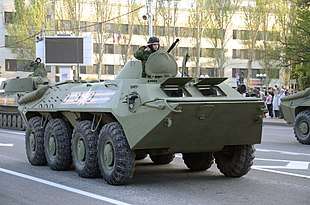 |
Armoured personnel carrier | 39[38] | In Special Forces. Upgraded BTR-70MB1. | |
| BTR-80 |  |
Armoured personnel carrier | 153[38] | In Special Forces. | |
| MT-LB | .jpg) |
Armoured personnel carrier | 50[38] | ||
Armored cars
| Model | Image | Origin | Type | Number | Notes |
|---|---|---|---|---|---|
| BRDM-2 | 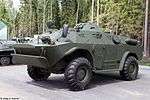 |
Amphibious Armoured Scout Car | |||
Artillery
Anti-air defenses
| Model | Image | Origin | Type | Number | Notes |
|---|---|---|---|---|---|
| 2K22 Tunguska (SA-19 Grison) | .jpg) |
Tracked SPAAW | - | ||
| 9K33 Osa (SA-8 Gecko) | 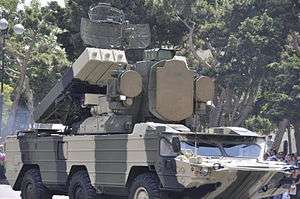 |
6×6 amphibious SAM system | 24 batteries | ||
| 9K35 Strela-10 | .jpg) |
Vehicle-mounted SAM system | 350 | ||
| Tor missile system | .jpg) |
Tracked SAM system | 20 Tor-M2s | 4 Tor-M2s ordered[55][56][57] | |
| S-300PS (SA-10 Grumble) S-300V (SA-12 Giant/Gladiator) |
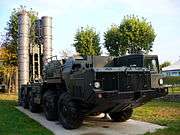  |
Long-range SAM system | 12 12 |
S-300PS systems delivered from Russia in 2007 to replace older S-300 model in Belarusian inventory.[58] Four divisions of S-300 missiles to be delivered in 2014.[59] | |
| 9K37 Buk (SA-11 Gadfly) | Medium range SAM system | 12 | |||
| S-400 missile system |  |
Long-Range Mobile surface-to-air missile system | 2 Batteries | Announced their intentions to purchase the S-400 in September 2011.[60] Deliveries started in 2015 (official statement).[61][62] 2 systems in 2016.[63] | |
Other
- Dongfeng EQ2058s
- Lis-PM
- DongFeng Mengshi EQ2050F named Bogatyr in the Belarusian army[64]
- MZKT-490100
- Dajiang CS/VN3 Drakon[65]
- Bogomol UCGV[66]
- Burevestnik-MB armed drone
- Busel-MB reconnaissance drone[67]
- Berserk combat UGV[68][69]
- Centaur UCGV[66]
- 2B23 Nona-M1 semi-automatic breech-loading 120 mm towed mortars
- Sopka-2M radar station[70]
- Groza-R2 handheld VHF jamming counter-unmanned aerial vehicle systems[71]
- Protivnik-G, Vostok-D and Rosa-RBM radar stations
- Garant-AKPP automated control post
- MKR Argus-P1 mobile radio monitoring system
- Peleng radio technical reconnaissance system[72]
- UAZ Patriot[73]
Cultural aspects
Institutions/units
- Museum of Military History of Belarus
- Military Band Service of the Armed Forces
- Belarusian Armed Forces Academic Song and Dance Ensemble
- Central House of Officers (Minsk)
- Drama Theatre of the Belarusian Army
- Honor Guard of the Armed Forces of Belarus
- Belarusian Great Patriotic War Museum
Holidays
- In Belarus, the holiday annual Defender of the Fatherland Day (known as Дзень абаронцы Айчыны in the Belarusian language) celebrations on 23 February also coincide with the Day of the Armed Forces (Дзень Узброеных Сіл). It commemorates that day 1918 when the first unified military in the country was established as part of the Red Army. Officially declared a public holiday by President Lukashenko on 25 March 2004, it has traditionally been honoured with a wreath laying ceremony by the President of Belarus on Victory Square. Joint festive events with soldiers of the Russian Armed Forces soldiers are also hold on 23 February in connection with their professional holiday. During the centennial of the armed forces in 2018, events were held throughout the year, including a military parade in Gomel and celebrations in Vitebsk.[74][75][76]
- Although a national holiday, Independence Day is primarily an armed forces celebration which honours those who took part in the Red Army's 1944 Minsk Offensive. The Minsk Independence Day Parade is the main military event done on this day.
Popular songs/marches
The following is a list of notable Belarusian military pieces:[77][78]
- Motherland My Dear (Радзіма мая дарагая)
- Victory March (Марш Перамогi)
- Den Pobedy (Дзень Перамогі)
- Anthem of the Military Academy (Гимн Военной академии)
- Grenadier March (Марш Грэнадыі)
- Our Fatherland's Flag (Айчыны нашай сцяг)[79]
- Song from 45 (Письмо из 45-го)
Military education
- Military Academy of Belarus
- Ministry of the Interior Academy of Belarus
- Border Guard Service Institute of Belarus
- Minsk Suvorov Military School
- Military Faculty of the Belarusian State University – The faculty was established on 4 November 1926, by order of the Revolutionary Military Council. In 1941, at the beginning of the Great Patriotic War, military training classes were interrupted only to be resumed in 1943. In the post-war and subsequent years, the military department continued to train reserve officers from among the students in the required military accounting specialties. In 2003, the military department was reorganized into the modern military faculty of Belarusian State University.[80]
- Military Faculty of the Belarusian State University of Informatics and Radioelectronics
- Military Faculty of the Belarusian National Technical University
- Military Faculty of the Belarusian State Medical University
- Military Faculty of the Grodno State University
- Military Faculty of the Belarusian State University of Transport
- Military Faculty of the Belarusian State Academy of Aviation
References
- "Сухопутные войска Республики Беларусь - Армия Беларуси". belarmy.by. Archived from the original on 2018-04-13. Retrieved 6 April 2018.
- "В белорусской армии служит 62 тысячи человек". Archived from the original on 2014-12-24. Retrieved 23 December 2014.
- "Armed forces - Belarus". Archived from the original on 2014-10-28. Retrieved 23 December 2014.
- John Pike. "Ground Forces". Archived from the original on 2014-10-15. Retrieved 23 December 2014.
- "Military expenditure in current prices". Archived from the original on 2018-05-17. Retrieved 2018-05-17.
- "The Military Balance 2017". The Military Balance. 117: 203–204. 2017 – via Taylor and Francis.
- Dr Steven J Main, The Belarusian Armed Forces: A Military-Political History 1991–2003 Archived 2008-03-06 at the Wayback Machine, Conflict Studies Research Centre, RMA Sandhurst, 2003.
- "Selected Bibliography of works on the struggle for Belarusian Independence 1900–1921 in the Francis Skaryna Belarusian Library in London". Archived from the original on September 27, 2013. Retrieved May 22, 2020.
- I N Rodionov, ed, Belorusskiy voyennyy okrug, Military Encyclopedia, t1, "Voyennoye izdatel'stvo", Moscow, 1997, 422, cited in Main, 2003, 6.
- Pavel Bykovsky & Alexander Vasilevich, Military Development and the Armed Forces of Belarus Archived 2007-12-05 at the Wayback Machine, Moscow Defence Brief, CAST, 2007
- Richard Woff, 'Minsk: making limited progress with reform,' Jane's Intelligence Review, June 1996, 248.
- Russia, Belarus to sign agreement on joint air defence system Archived 2009-02-12 at the Wayback Machine, RIA Novosti via GlobalSecurity.org, 19 October 2006.
- "Ministry of Defence of RB - News". Archived from the original on 2 May 2006. Retrieved 23 December 2014.
- Library of Congress Country Studies, Ground Forces, in A Country Study: Belarus, June 1995
- Feskov et al. 2004, 53, with five artillery brigades and two independent battalions.
- Including the 43rd (OTR-21 Tochka) and 76th (8 НУ 9КЛг) Rocket Brigades at Zaslonovo, probably.
- Soldat.ru, Brigades of the Belarus Armed Forces Archived 2013-01-17 at the Wayback Machine, accessed December 2012.
- Main, 2003
- http://www.ryadovoy.ru/forum/index.php/topic,406.0.html Archived 2012-04-17 at the Wayback Machine
- Formed Maryina Gorka, Minsk Oblast, 1 January 1963as the 5th Special Forces Brigade GRU. Two battalions. On 3.4.78 renamed 5th independent Special Forces Brigade GRU. Took the oath of allegiance to Belarus on 31 December 1992. Michael Holm, 5th independent Special Forces Brigade Archived 2014-02-02 at the Wayback Machine, accessed 2014.
- One of the equipment storage bases is the 19th, the former 19th Guards Tank Division at Zaslonovo in the Lepiel region. On October 1, 2003, the base was considerably strengthened. From other bases of storage of arms and techniques now we are distinguished favorably by new structure. Besides a battalion of protection, storage and service, motor-rifle and tank battalions were added. "Archived copy". Archived from the original on 2008-05-13. Retrieved 2008-02-10.CS1 maint: archived copy as title (link).
- Vad777
- "Кто такие белорусские миротворцы, как они могут появиться в чужой стране и можно ли им стрелять?". TUT.BY. Dec 5, 2017. Retrieved May 22, 2020.
- На стороне Каддафи воюют белорусские партизаны — Комсомольская правда, 6 апреля 2011
- "Территориальная оборона в системе национальной безопасности — Военный информационный портал Министерства обороны Республики Беларусь".
- "Strengthening Territorial Defence, New Military Priorities, NATO Dialogue – Belarus Security Digest | BelarusDigest".
- "Территориальные войска сегодня" (PDF). Retrieved May 22, 2020.
- "Законы Республики Беларусь о защите республики". lektsii.org. Retrieved May 22, 2020.
- "Войска территориальной обороны (ТерО) Республики Беларусь". www.modernarmy.ru. Retrieved May 22, 2020.
- "Blogger". accounts.google.com. Retrieved May 22, 2020.
- "Специальные войска — Военный информационный портал Министерства обороны Республики Беларусь". www.mil.by. Retrieved May 22, 2020.
- "State Border Committee". Gpk.gov.by. Retrieved 23 January 2019.
- "Taras Seredyuk, the State Border Committee of the Republic of Belarus". rovienna.iom.int. Dec 8, 2017. Retrieved May 22, 2020.
- "ВООРУЖЕННЫЕ СИЛЫ РЕСПУБЛИКИ БЕЛАРУСЬ НА СОВРЕМЕННОМ ЭТАПЕ РАЗВИТИЯ — Во славу Родины". vsr.mil.by (in Russian). Archived from the original on 2018-01-15. Retrieved 2018-01-14.
- "Военные комендатуры Вооруженных Сил — Военный информационный портал Министерства обороны Республики Беларусь". Archived from the original on 2018-05-19. Retrieved 2018-05-18.
- "Парады и порядок — Газета "Минский курьер"". Retrieved May 22, 2020.
- "Belarus re-arms airborne troops | Jane's 360". Archived from the original on 2018-08-08. Retrieved 2018-08-08.
- International Institute for Strategic Studies (IISS) (9 February 2016). "The Military Balance 2016". The Military Balance. 116: 181–183. doi:10.1080/04597222.2016.1127558.
- "On the purchase of Su-30SM for the Belarusian Air Force". 20 June 2017. Archived from the original on 2018-07-23. Retrieved 23 July 2018.
- IISS Military Balance 2018, p.186.
- "На смену тяжелому 7,62–миллиметровому автомату АКМС с прибором для бесшумной и беспламенной стрельбы пришел 9–миллиметровый бесшумный малогабаритный автомат 9А–91"
Александр Макаров. Полк высоких технологий. Силы специальных операций // журнал "Спецназ", июль 2011 - "Ствол, с которым идут в разведку | Еженедельник "Военно-промышленный курьер"". vpk-news.ru. Retrieved May 22, 2020.
- Александр Макаров. Полк высоких технологий. Силы специальных операций // журнал "Спецназ", июль 2011
- "Archived copy". Archived from the original on 2019-02-02. Retrieved 2019-02-02.CS1 maint: archived copy as title (link)
- IISS Military Balance 2018, 185.
- "Belarus introduces first T-72B3M in its army 80606171 | June 2017 Global Defense Security news industry | Defense Security global news industry army 2017 | Archive News year". Archived from the original on 2018-08-24. Retrieved 2018-08-23.
- "More T-72B3 tanks for Belarus | November 2018 Global Defense Security army news industry | Defense Security global news industry army 2018 | Archive News year". Archived from the original on 2018-11-24. Retrieved 2018-11-23.
- "ЦАМТО / Новости / На форуме "Армия-2019" подписан ряд контрактов в сфере ВТС с Республикой Беларусь". armstrade.org. Retrieved May 22, 2020.
- "ARMY – 2019: First Contracts Signed — Military information portal of the Ministry of Defence of Republic of Belarus". www.mil.by. Retrieved May 22, 2020.
- "Janes | Latest defence and security news". Janes.com. Archived from the original on May 18, 2020. Retrieved May 22, 2020.
- "A Brief Guide to Russian Armored Fighting Vehicles". Dec 8, 2001. Archived from the original on 2001-12-08. Retrieved May 22, 2020.
- Belarus Army Equipment. Globalsecurity.org. Retrieved on 28 June 2019.
- IISS Military Balance 2018, p. 185.
- Military Balance 2016, p. 101
- "Third battery of Tor-M2 air defense missile system enters in service with the Belarus army". January 4, 2014. Archived from the original on 2014-01-10. Retrieved 2014-01-10.
- "Belarus and Russia sign contract on battery of Tor-M2 air defense missile systems". Archived from the original on 2018-11-29. Retrieved 2018-11-28.
- "Archived copy". Archived from the original on 2018-11-29. Retrieved 2018-11-28.CS1 maint: archived copy as title (link)
- "Russia completes S-300PS deliveries to Belarus". articles.janes.com. 14 June 2006. Archived from the original on 2012-05-03. Retrieved 7 August 2011.
- Russia will deliver four divisions of S-300 ground-to-air defense missile systems to Belarus Archived 2018-03-16 at the Wayback Machine - Armyrecognition.com, 24 April 2013
- "Kazakhstan to get first S-400 air defense systems after 2015". En.tengrinews.kz. 2013-03-15. Retrieved 2013-10-29.
- Денис Тельманов. "ПВО России и Белоруссии получит С-400 и цифровое управление". Известия. Archived from the original on 2017-03-20. Retrieved 2018-03-16.
- "Россия установит в Белоруссии ракетные системы С-400 "Триумф"". KM.RU Новости – новости дня, новости России, последние новости и комментарии. Archived from the original on 2018-08-22. Retrieved 2018-03-16.
- "Россия поставила Белоруссии две зенитных ракетных системы С-400". rns.online. 28 June 2016. Archived from the original on 2018-08-22. Retrieved 6 April 2018.
- https://www.armyrecognition.com/july_2018_global_defense_security_army_news_industry/belarus_parades_new_armored_vehicles_on_independence_day_military_parade_2018.html
- "Belarus parades new armored vehicles on Independence Day military parade 2018 | July 2018 Global Defense Security army news industry | Defense Security global news industry army 2018 | Archive News year". Archived from the original on 2018-07-09. Retrieved 2018-07-17.
- "ADEX 2018: BSVT highlighting new family of combat UGVs". www.armyrecognition.com. Retrieved 2019-03-07.
- "Local-made Burevestnik-MB armed drone in service with Belarus army | July 2018 Global Defense Security army news industry | Defense Security global news industry army 2018 | Archive News year". Archived from the original on 2018-07-17. Retrieved 2018-07-17.
- "New armed robot Centaur unveiled by Belarus army at military parade | weapons defence industry military technology UK | analysis focus army defence military industry army". Archived from the original on 2018-07-17. Retrieved 2018-07-17.
- "BSVT rolls out production ready Berserk combat UGV | Jane's 360". Archived from the original on 2018-11-13. Retrieved 2018-11-13.
- "Archived copy". Archived from the original on 2018-08-24. Retrieved 2018-08-24.CS1 maint: archived copy as title (link)
- "Analysis: Belarus receives two first Su-30SM fighters". airrecognition.com. Retrieved May 22, 2020.
- https://armstrade.org/includes/periodics/news/2020/0702/110058546/detail.shtml
- http://www.mod.gov.rs/eng/16253/novih-56-terenskih-vozila-za-vojsku-srbije-16253
- "ВИДЕО. Военный парад к 100-летию Вооружённых Сил Республики Беларусь. Гродно, 23 февраля 2018 года". Retrieved May 22, 2020.
- "День защитников Отечества и Вооруженных Сил Республики Беларусь — Военный информационный портал Министерства обороны Республики Беларусь". www.mil.by. Retrieved May 22, 2020.
- "День вооружения Вооруженных Сил — Военный информационный портал Министерства обороны Республики Беларусь". www.mil.by. Retrieved May 22, 2020.
- "StackPath". belsat.eu. Retrieved May 22, 2020.
- "Военные песни — Военный информационный портал Министерства обороны Республики Беларусь". www.mil.by. Retrieved May 22, 2020.
- "Айчыны нашай сцяг". vuchoba.org. Retrieved May 22, 2020.
- "О Факультете — Военный информационный портал Министерства обороны Республики Беларусь". www.mil.by. Retrieved May 22, 2020.

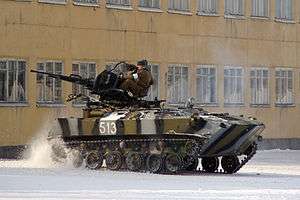

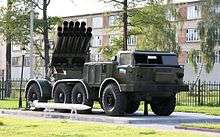

.jpg)
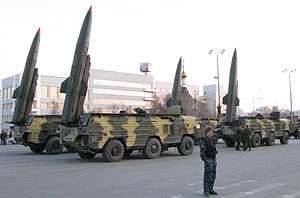
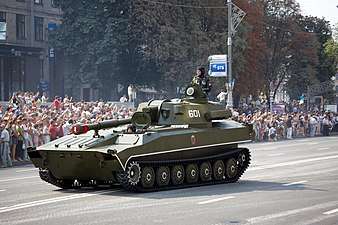
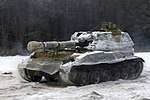
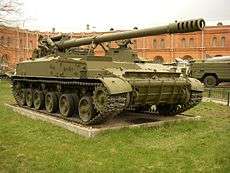

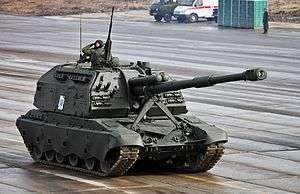
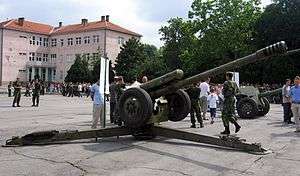

.jpg)
.svg.png)